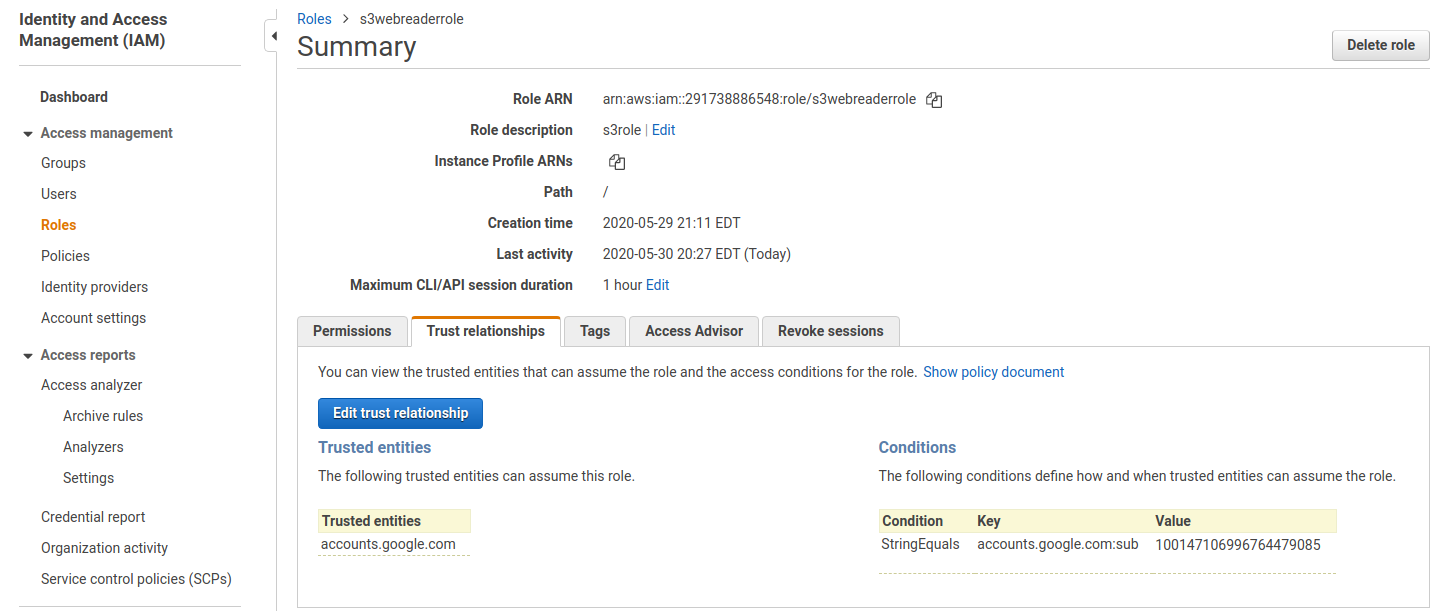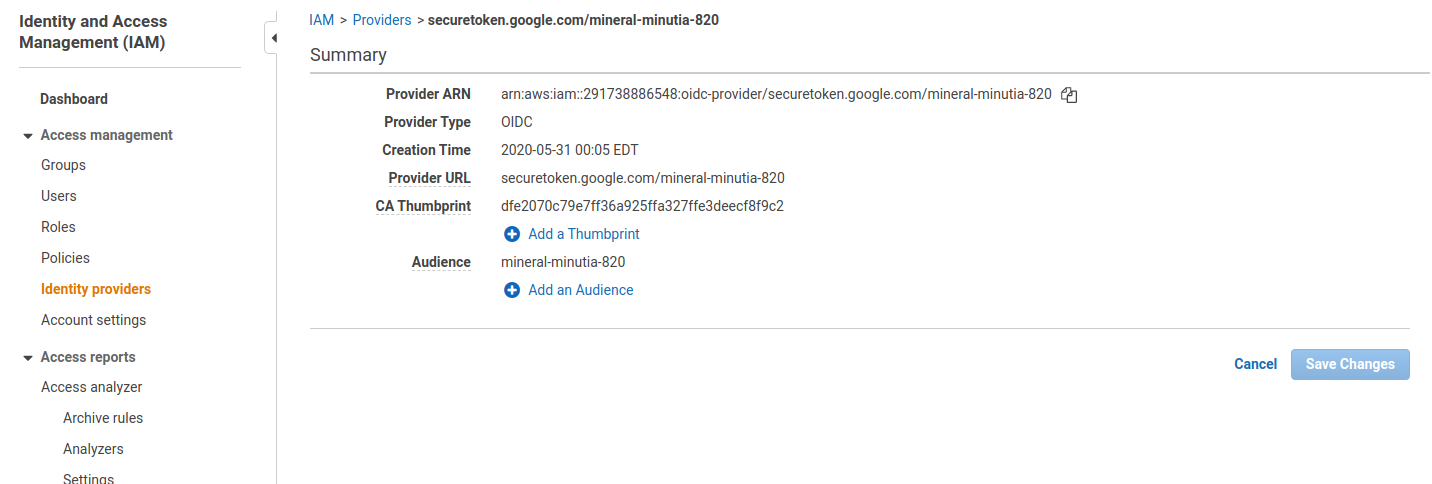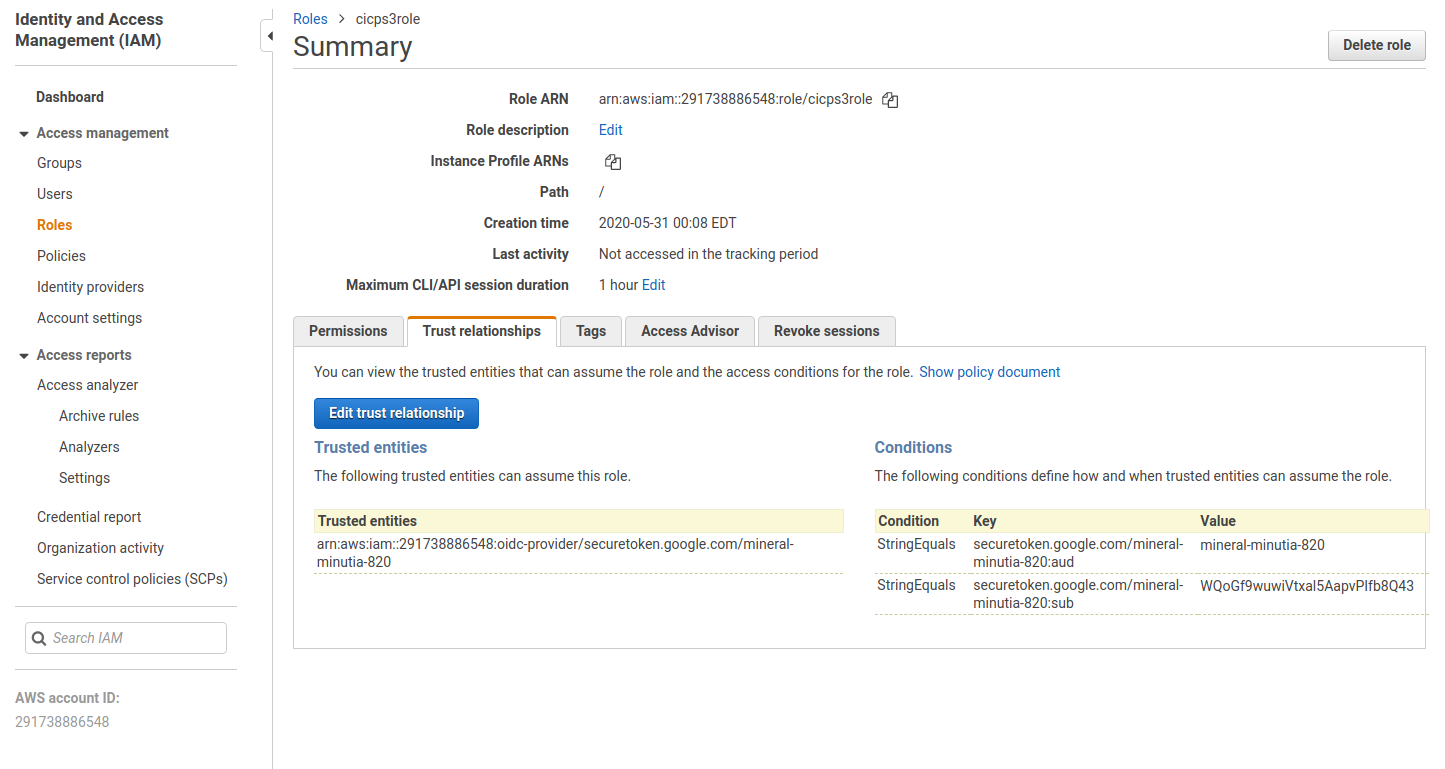Federate Google Cloud OIDC tokens for AWS Access Tokens
2022-08-11Tutorial and golang library that will federate a google id token token for AWS STS access tokens (GCP Credentials –> AWS Resources)
In other words, a simple AWS Credential Provider that uses Google OIDC tokens.
Essentially, this will allow you to use a google id_token for AWS STS session_token and then access an aws resource that you’ve configured an Access Policy for the google identity. This repo creates an AWS Credential derived from a Google Credential with the intent of using it for AWS’s IAM Role using External Identities.
Firebase and Google Cloud Identity Platform based id_tokens can also be uses for this exchange but is not wrapped into this library (critically since there isn’t a golang client library to acquire them).
NOTE: the code in this repo is not supported by google.
You can find the source here
this repo is not supported by google
References
AWS
- AWS Identity Providers and Federation
- AWS WebIdentityRoleProvider
- AWS AssumeRoleWithWebIdentity
- aws.credential.Provider
- Authenticating using Google OpenID Connect Tokens
- Securely Access AWS Services from Google Kubernetes Engine (GKE)
- https://accounts.google.com/.well-known/openid-configuration
Firebase
- for GCP Credentials –> Azure Resources see Federate Google Cloud OIDC tokens for Azure Access Tokens
- for Arbitrary OIDC Provider –> GCP Resources see GCP Workload Identity Federation using OIDC Credentials
- for Arbitrary SAML Provider –> GCP Resources see GCP Workload Identity Federation using SAML Credentials
- for AWS Credentials –> GCP Resources see GCP Workload Identity Federation using AWS Credentials
Google OIDC
AWS already supports Google OIDC endpoint out of the box as a provider so the setup is relatively simple: just define an AWS IAM policy that includes google and restrict it with a Condition that allows specific external identities as shown below:
- The following definition refers to Role:
arn:aws:iam::291738886548:role/s3webreaderrole
{
"Version": "2012-10-17",
"Statement": [
{
"Effect": "Allow",
"Principal": {
"Federated": "accounts.google.com"
},
"Action": "sts:AssumeRoleWithWebIdentity",
"Condition": {
"StringEquals": {
"accounts.google.com:sub": "100147106996764479085"
}
}
}
]
}

To do this by hand, first acquire an ID token (in this case through gcloud cli and service account):
For the sake of simplicity, we will create a service account on GCP and download a service account key.
In practice, its not advisable to download an actual key (it has security risks there)…but since this is a tutorial, we can do this.
If you intend to run in cloud run, cloud functions, gke or gce vm (or on prem), you can use impersonation even abstract with workload federation
$ export PROJECT_ID=`gcloud config get-value core/project`
$ gcloud iam service-accounts create svc-2-429 --display-name "Federated Service Account"
$ gcloud iam service-accounts keys create svc_account.json --iam-account svc-2-429@$PROJECT_ID.iam.gserviceaccount.com
$ gcloud auth activate-service-account --key-file=/path/to/gcp_service_account.json
$ export TOKEN=`gcloud auth print-identity-token --audiences=https://foo.bar`
Decode the token using the JWT decoder/debugger at jwt.io
The token will show the unique sub field that identifies the service account:
{
"aud": "https://foo.bar",
"azp": "svc-2-429@mineral-minutia-820.iam.gserviceaccount.com",
"email": "svc-2-429@mineral-minutia-820.iam.gserviceaccount.com",
"email_verified": true,
"exp": 1590898991,
"iat": 1590895391,
"iss": "https://accounts.google.com",
"sub": "100147106996764479085"
}
Or using gcloud cli again:
$ gcloud iam service-accounts describe svc-2-429@mineral-minutia-820.iam.gserviceaccount.com
displayName: Service Account A
email: svc-2-429@mineral-minutia-820.iam.gserviceaccount.com
etag: MDEwMjE5MjA=
name: projects/mineral-minutia-820/serviceAccounts/svc-2-429@mineral-minutia-820.iam.gserviceaccount.com
oauth2ClientId: '100147106996764479085'
projectId: mineral-minutia-820
uniqueId: '100147106996764479085'
Use this uniqueId value in the AWS IAM Role policy as shown above.
Note: I tried to specify an audience value (
"accounts.google.com:aud": "https://someaud") within the AWS policy but that didn’t seem to work) Which means while theaudience(aud) value is specified in some of the samples here (eg"https://sts.amazonaws.com/orhttps://foo.bar) can be anything since its not even currently used in the AWS condition policy)
Export the token and invoke the STS endpoint using the RoleArn= value defined earlier
export TOKEN=eyJhbGciOiJSUzI1...
$ curl -s "https://sts.amazonaws.com/?Action=AssumeRoleWithWebIdentity&DurationSeconds=3600&RoleSessionName=app1&RoleArn=arn:aws:iam::291738886548:role/s3webreaderrole&WebIdentityToken=$TOKEN&Version=2011-06-15&alt=json"
You should see AWS Credential object in the response
<AssumeRoleWithWebIdentityResponse xmlns="https://sts.amazonaws.com/doc/2011-06-15/">
<AssumeRoleWithWebIdentityResult>
<Audience>svc-2-429@mineral-minutia-820.iam.gserviceaccount.com</Audience>
<AssumedRoleUser>
<AssumedRoleId>AROAUH3H6EGKKRVTHVAVB:app1</AssumedRoleId>
<Arn>arn:aws:sts::291738886548:assumed-role/s3webreaderrole/app1</Arn>
</AssumedRoleUser>
<Provider>accounts.google.com</Provider>
<Credentials>
<AccessKeyId>ASIAUH3H6EGKPI...</AccessKeyId>
<SecretAccessKey>EM3Zu4RlDOKGkFPJpceemRqEzfazLk...</SecretAccessKey>
<SessionToken>FwoGZXIvYXd...</SessionToken>
<Expiration>2020-05-31T04:23:39Z</Expiration>
</Credentials>
<SubjectFromWebIdentityToken>100147106996764479085</SubjectFromWebIdentityToken>
</AssumeRoleWithWebIdentityResult>
<ResponseMetadata>
<RequestId>38dd604d-6ce2-45b3-8e6f-1165ae0e24a1</RequestId>
</ResponseMetadata>
</AssumeRoleWithWebIdentityResponse>
You can manually export the Credential in an cli (in this case, to access s3)
export AWS_ACCESS_KEY_ID=ASIAUH3H6EGKIL...
export AWS_SECRET_ACCESS_KEY=+nDF8O2yLDH13ug...
export AWS_SESSION_TOKEN=FwoGZXIvYXd...
$ aws s3 ls mineral-minutia --region us-east-2
2020-05-29 23:04:07 213 main.py
To make this easier, the golang library contained in this repo wraps these steps and provides an AWS Credential object for you:
Usage
There are several ways to exchange GCP credentials for AWS:
You can either delegate the task to get credentials to an external AWS ProcessCredential binary or perform the exchange in code as shown in this repo.
Process Credentials
In the ProcessCredential approach, AWS’s client library and CLI will automatically invoke whatever binary is specified in aws’s config file. That binary will acquire a Google IDToken and then exchange it for a WebIdentityToken SessionToken from the AWS STS server. Finally, the binary will emit the tokens to stdout in a specific format that AWS expects.
For more information, see Sourcing credentials with an external process and AWS Configuration and credential file settings
To use the process credential binary here, first
- Build the binary
go build -o gcp-process-credentials main.go
- Create AWS Config file
create a config file under ~/.aws/config and specify the path to the binary, the ARN role and optionally the path to a specific gcp service account credential.
[default]
credential_process = /path/to/gcp-process-credentials --aws-arn arn:aws:iam::291738886548:role/s3webreaderrole --gcp-credential-file /path/to/svc.json
In the snippet above, i’ve specified the GCP ServiceAccount Credentials file path. If you omit that parameter, the binary will use Google Application Default Credential to seek out the appropriate Google Credential Source.
For example, if you run the binary on GCP VM, it will use the metadata server to get the id_token. If you specify the ADC Environment varible GOOGLE_APPLICATION_CREDENTIALS=/path/to.json, the binary will use the service account specified there
- Invoke AWS CLI or SDK library
Then either use the AWS CLI or any SDK client in any language. The library will invoke the process credential for you and acquire the AWS token.
$ aws s3 ls mineral-minutia --region us-east-2
The example output from the binary is just JSON:
$ gcp-process-credentials --aws-arn arn:aws:iam::291738886548:role/s3webreaderrole --gcp-credential-file /path//to/svc.json | jq '.'
{
"Version": 1,
"AccessKeyId": "ASIAUH3H6EGKL7...",
"SecretAccessKey": "YnjWyQFDeeqkRVJQit2uaj+...",
"SessionToken": "FwoGZ...",
"Expiration": "2020-06-05T19:24:57+0000"
}
Language Native
The other approach is to exchange the GoogleID token for an AWS one using the AWS Language library itself. This has the advantage of being “self contained” in that there is no need for an external binary to get installed on the system.
The snippet below demonstrate how to do this in various languages. For golang and java specifically, the exchange is done a custom AWS credential wrapper which has the distinct advantage of being “managed” just like any other standard AWS Credential type in that any refresh() that is needed on the underlying credential will be self-managed.
At the moment (5/5/20), I havne’t been able to figure out how to do this with python..
Golang
To use the managed credential in golang, import "github.com/salrashid123/awscompat/google" as shown below
package main
import (
"context"
"fmt"
"github.com/aws/aws-sdk-go/aws"
"github.com/aws/aws-sdk-go/aws/session"
"github.com/aws/aws-sdk-go/service/s3"
"github.com/aws/aws-sdk-go/service/sts"
"io/ioutil"
"log"
"time"
awscompat "github.com/salrashid123/awscompat/google"
"golang.org/x/oauth2/google"
"google.golang.org/api/idtoken"
)
const ()
func main() {
aud := "https://foo.bar"
jsonCert := "/path/to/svc.json"
ctx := context.Background()
ts, err := idtoken.NewTokenSource(ctx, aud, idtoken.WithCredentialsFile(jsonCert))
// or on GCE/GKE/Run/GCF, omit the certificate file
//ts, err := idtoken.NewTokenSource(ctx, aud)
if err != nil {
log.Fatalf("unable to create TokenSource: %v", err)
}
creds, err := awscompat.NewGCPAWSCredentials(ts, &sts.AssumeRoleWithWebIdentityInput{
RoleArn: aws.String("arn:aws:iam::291738886548:role/s3webreaderrole"),
RoleSessionName: aws.String("app1"),
})
if err != nil {
log.Fatalf("Error creatint Credentials %v", err)
}
sess, err := session.NewSession(&aws.Config{
Credentials: &creds,
Region: aws.String("us-east-2")},
)
svcs3 := s3.New(sess)
sresp, err := svcs3.ListObjectsV2(&s3.ListObjectsV2Input{Bucket: aws.String("mineral-minutia")})
if err != nil {
log.Fatalf("Error listing objects: %v", err)
}
for _, item := range sresp.Contents {
fmt.Printf("Name %v %v\n:", time.Now(), *item.Key)
}
}
Just note
-
"google.golang.org/api/idtoken"will only provideid_tokensfor service accounts. It does not support user-based id_tokens. -
If for some reason you need to first acquire an impersonated credential’s
id_token, you will need to first acquire Google Credentials that represents the impersonated account (ImperstonatedTokenSource) and then apply it into theIdTokenSource). (i.,e you need to two Google TokenSources together and provide the final id_token to the library in this repo)
For more information, see google.impersonatedTokenSource and code
For that matter, you could use "github.com/salrashid123/oauth2/google" as the id_token provider on GCP as shown below but that is unsupported (this repo is also unsupported)
import (
sal "github.com/salrashid123/oauth2/google"
)
scopes := "https://www.googleapis.com/auth/userinfo.email"
data, err := ioutil.ReadFile(jsonCert)
if err != nil {
log.Fatal(err)
}
gcreds, err := google.CredentialsFromJSON(ctx, data, scopes)
if err != nil {
log.Fatal(err)
}
ts, err := sal.IdTokenSource(
&sal.IdTokenConfig{
Credentials: gcreds,
Audiences: []string{aud},
},
)
Java
In Java, the GCPAWSCredentialProviderl is included directly in this repo (java/src/main/java/com/google/awscompat/GCPAWSCredentialProvider.java) as well as the test app that acquired googleID tokens from various sourcesjava/src/main/java/com/test/Main.java
// Using default ProcessCredentials
// AmazonS3 s3 =
// AmazonS3ClientBuilder.standard().withRegion(Regions.US_EAST_2).build();
// or
// Get an IDToken from the source system.
// IdTokenCredentials tok = tc.getIDTokenFromComputeEngine(target_audience);
// in this case, its using a service account file:
ServiceAccountCredentials sac = ServiceAccountCredentials.fromStream(new FileInputStream(credFile));
sac = (ServiceAccountCredentials) sac.createScoped(Arrays.asList(CLOUD_PLATFORM_SCOPE));
IdTokenCredentials tok = tc.getIDTokenFromServiceAccount(sac, target_audience);
// then specify the GCPAWSCredentialProvider.googleCredential() value
String roleArn = "arn:aws:iam::291738886548:role/s3webreaderrole";
AmazonS3 s3 = AmazonS3ClientBuilder.standard().withRegion(Regions.US_EAST_2)
.withCredentials(GCPAWSCredentialProvider.builder().roleArn(roleArn).roleSessionName(null)
.googleCredentials(tok).build())
.build();
Python
For Python, a similar flow to acquire a google ID token manually and then add the raw SessionToken value in:
# For other sources of IDTokens, see
# https://github.com/salrashid123/google_id_token/blob/master/python/googleidtokens.py#L33
def getIdToken():
svcAccountFile ="/path/to/svc.json"
target_audience="https://sts.amazonaws.com"
creds = service_account.IDTokenCredentials.from_service_account_file(
svcAccountFile,
target_audience= target_audience)
request = google.auth.transport.requests.Request()
creds.refresh(request)
return creds.token
# Using Specify Credentials and SessionToken
sts_client = boto3.client('sts')
assumed_role_object = sts_client.assume_role_with_web_identity(
RoleArn="arn:aws:iam::291738886548:role/s3webreaderrole",
RoleSessionName="AssumeRoleSession1",
WebIdentityToken=getIdToken(),
DurationSeconds=900
)
credentials = assumed_role_object['Credentials']
s3_resource = boto3.resource(
's3',
aws_access_key_id=credentials['AccessKeyId'],
aws_secret_access_key=credentials['SecretAccessKey'],
aws_session_token=credentials['SessionToken'],
)
bkt = s3_resource.Bucket('mineral-minutia')
for my_bucket_object in bkt.objects.all():
print(my_bucket_object)
To Note, the boto3.resource() takes the raw value of the SessionToken which means once it expires, the s3_resource will also fail and not renew.
I havne’t been able to figure out how to create a managed Credential object in AWS python boto library set that would handle the refresh of the underlying token for you.
Dotnet
For dotnet, you can either acquire a GoogleOIDC token and inject it into a static STS client or use the wrapped GoogleCompatCredentials object provided in this repo
public class GoogleCompatCredentials : RefreshingAWSCredentials
The usage of both modes is shown in dotnet/Main.cs while if you just want to use the wrapped version:
You can bootstrap GoogleCompatCredentials using any Google source Credential object that implements its Google.Apis.Auth.OAuth2.IOidcTokenProvider interface. In the case below, its using ServiceAccountCredential
ServiceAccountCredential saCredential;
using (var fs = new FileStream(CREDENTIAL_FILE_JSON, FileMode.Open, FileAccess.Read))
{
saCredential = ServiceAccountCredential.FromServiceAccountData(fs);
}
var getSessionTokenRequest = new AssumeRoleWithWebIdentityRequest
{
RoleSessionName = "testsession",
RoleArn = roleArn,
};
var targetAudience = "https://sts.amazonaws.com/"; // this can be any value (not used in this example)
var cc = new GoogleCompatCredentials(saCredential, targetAudience, getSessionTokenRequest);
using (s3Client = new AmazonS3Client(cc, bucketRegion))
{
var listObjectRequest = new ListObjectsRequest
{
BucketName = bucketName
};
ListObjectsResponse response = await s3Client.ListObjectsAsync(listObjectRequest);
List<S3Object> objects = response.S3Objects;
foreach (S3Object o in objects) {
Console.WriteLine("Object = {0}", o.Key);
}
}
nodejs
For node, you can either acquire a GoogleOIDC token and inject it into a static STS client or use the wrapped GoogleCompatCredentials object provided in this repo
const AWS = require('aws-sdk');
const { GoogleAuth } = require('google-auth-library');
AWS.config.region = 'us-east-2';
require('./google_compat_credentials.js');
const audience = 'https://sts.amazonaws.com/';
const roleArn = 'arn:aws:iam::291738886548:role/s3webreaderrole';
const auth = new GoogleAuth();
const client = await auth.getIdTokenClient(
audience
);
AWS.config.credentials = new GoogleCompatCredentials({
RoleArn: roleArn,
RoleSessionName: "testsession"
}, client);
var s3 = new AWS.S3();
var params = {
Bucket: 'mineral-minutia',
}
s3.listObjects(params, function (err, data) {
if (err) throw err;
console.log(data);
});
Firebase/Identity Platform OIDC
Firebase and Identity Platform can also provide OIDC tokens. For example, the OIDC .well-known endpoint below for a given Firebase Project is discoverable by AWS as an external provider:
For my Firebase/Cloud Identity Platform Project, (called mineral-minutia-820 below):
and compare that with the full OIDC capabilities of google:
But thats enough to get started. Unfortunately, there doesn’t seem to be a golan library to wrap as shown earlier. The following shows how to get a Firebase id_token using its nodeJS library using plain firebase.auth().signInWithEmailAndPassword
require("firebase/auth");
const email = "your@email.com";
const password = "yourpassword";
var firebaseConfig = {
apiKey: "...",
authDomain: "...",
projectId: "...",
storageBucket: "...",
};
firebase.initializeApp(firebaseConfig);
firebase.auth().signInWithEmailAndPassword(email, password).then(result => {
firebase.auth().currentUser.getIdToken(true).then(function(idToken) {
console.log(idToken);
}
}
You can find a sample Firebase app that acquires an id_token here:
Firebase Storage and Authorization Rules engine ‘helloworld’
Once you have the id_token, decode as done earlier to fin the sub value. THis will be unique to each Firebase project even if the same actual user logs into multiple projects.
First define an external provider:

When you specify the endpoint configuration for OIDC, just use the root URL for the discovery endpoint with the firebase projectID: https://securetoken.google.com/mineral-minutia-820
Then define a Role with the external provider: in my case the role was arn:aws:iam::291738886548:role/cicps3role

{
"Version": "2012-10-17",
"Statement": [
{
"Effect": "Allow",
"Principal": {
"Federated": "arn:aws:iam::291738886548:oidc-provider/securetoken.google.com/mineral-minutia-820"
},
"Action": "sts:AssumeRoleWithWebIdentity",
"Condition": {
"StringEquals": {
"securetoken.google.com/mineral-minutia-820:aud": "mineral-minutia-820",
"securetoken.google.com/mineral-minutia-820:sub": "WQoGf9wuwiVtxal5AapvPIfb8Q43"
}
}
}
]
}
The sub value is taken from the decoded id_token
{
"name": "sal a mander",
"admin": true,
"groupId": "12345",
"iss": "https://securetoken.google.com/mineral-minutia-820",
"aud": "mineral-minutia-820",
"auth_time": 1590897853,
"user_id": "WQoGf9wuwiVtxal5AapvPIfb8Q43",
"sub": "WQoGf9wuwiVtxal5AapvPIfb8Q43",
"iat": 1590897853,
"exp": 1590901453,
"email": "sal@somedomain.com",
"email_verified": false,
"firebase": {
"identities": {
"email": [
"sal@somedomain.com"
]
},
"sign_in_provider": "password"
}
}
As mentioned, the there is no golang library for FireBase so a direct invocation w/ curl will yeld the AWS Credential.
$ curl -s "https://sts.amazonaws.com/?Action=AssumeRoleWithWebIdentity&DurationSeconds=3600&RoleSessionName=app1&RoleArn=arn:aws:iam::291738886548:role/cicps3role&WebIdentityToken=$TOKEN&Version=2011-06-15&alt=json"
<AssumeRoleWithWebIdentityResponse xmlns="https://sts.amazonaws.com/doc/2011-06-15/">
<AssumeRoleWithWebIdentityResult>
<Audience>mineral-minutia-820</Audience>
<AssumedRoleUser>
<AssumedRoleId>AROAUH3H6EGKDE7GWMPWA:app1</AssumedRoleId>
<Arn>arn:aws:sts::291738886548:assumed-role/cicps3role/app1</Arn>
</AssumedRoleUser>
<Provider>arn:aws:iam::291738886548:oidc-provider/securetoken.google.com/mineral-minutia-820</Provider>
<Credentials>
<AccessKeyId>ASIAUH3H6EGKPJ...</AccessKeyId>
<SecretAccessKey>Z3S78e6hWYGlub6YlOgz6hYwo81...</SecretAccessKey>
<SessionToken>FwoGZXIvYXd...</SessionToken>
<Expiration>2020-05-31T05:11:05Z</Expiration>
</Credentials>
<SubjectFromWebIdentityToken>WQoGf9wuwiVtxal5AapvPIfb8Q43</SubjectFromWebIdentityToken>
</AssumeRoleWithWebIdentityResult>
<ResponseMetadata>
<RequestId>5959ed62-13ac-4205-a0f6-811f00bced6b</RequestId>
</ResponseMetadata>
</AssumeRoleWithWebIdentityResponse>
One more note about Firebase/Cloud Identity Platform: You can use it to define external identities itself (eg, Google, Facebook, AOL, other OIDC, other SAML, etc).
That means you can chain identities together though Identity Platform.
Turtles all the way down (or atleast a couple of levels).
This site supports webmentions. Send me a mention via this form.